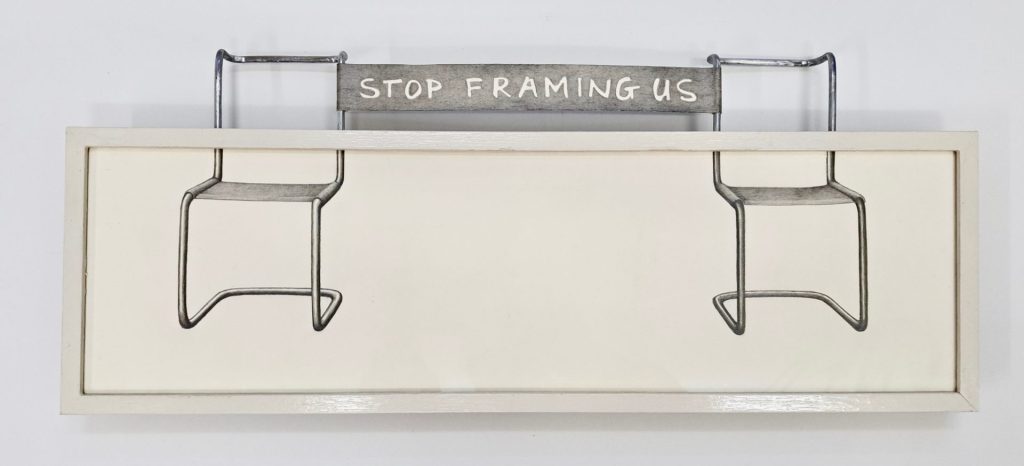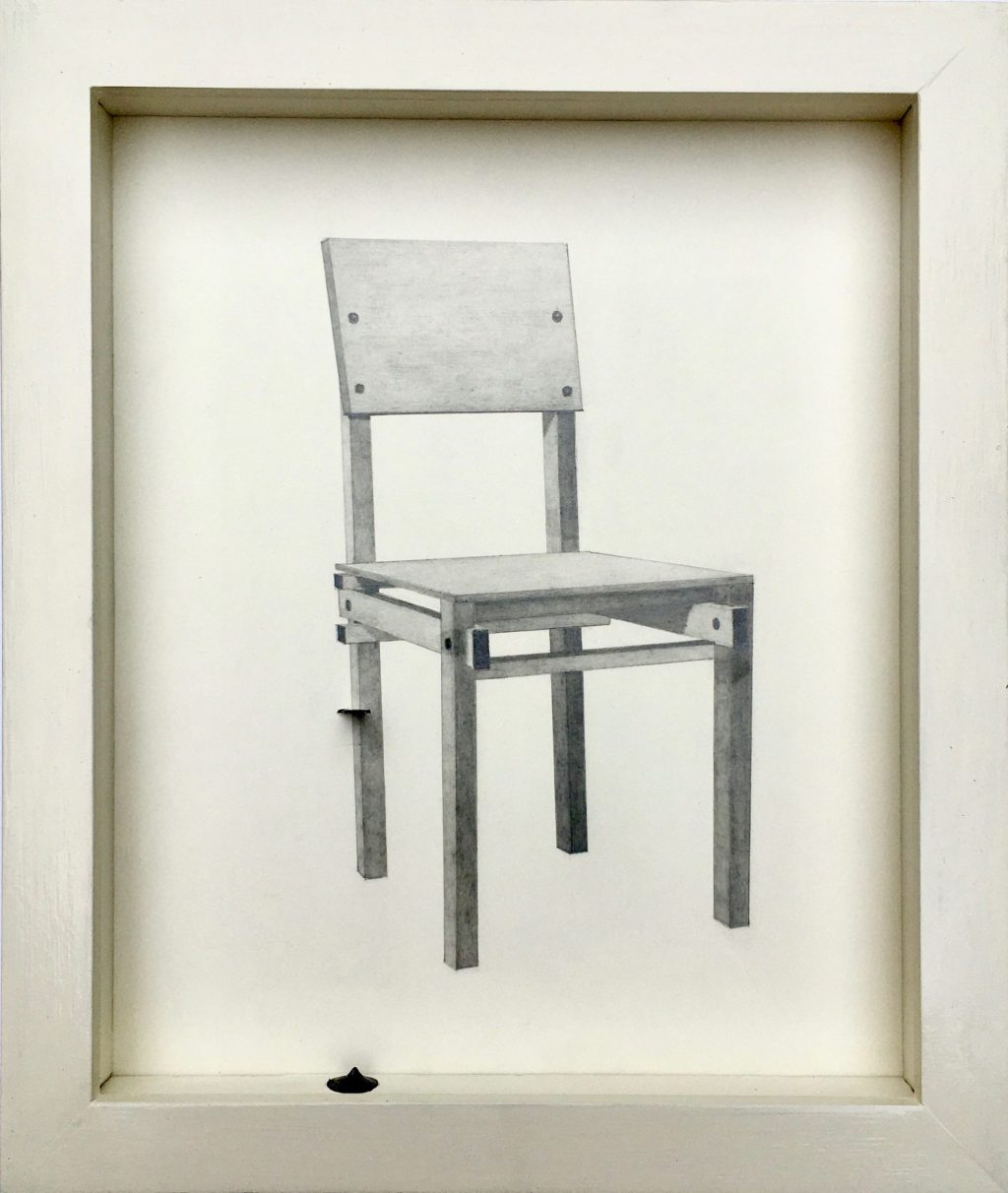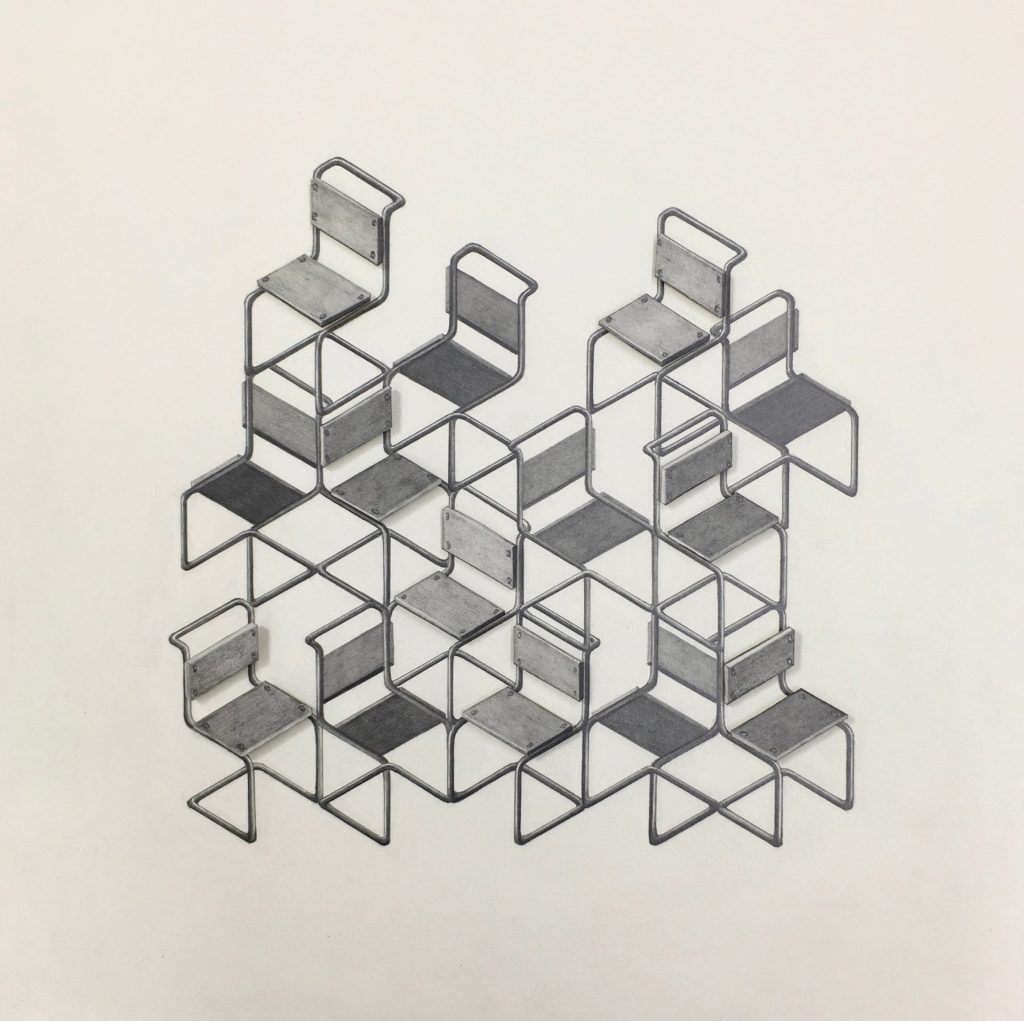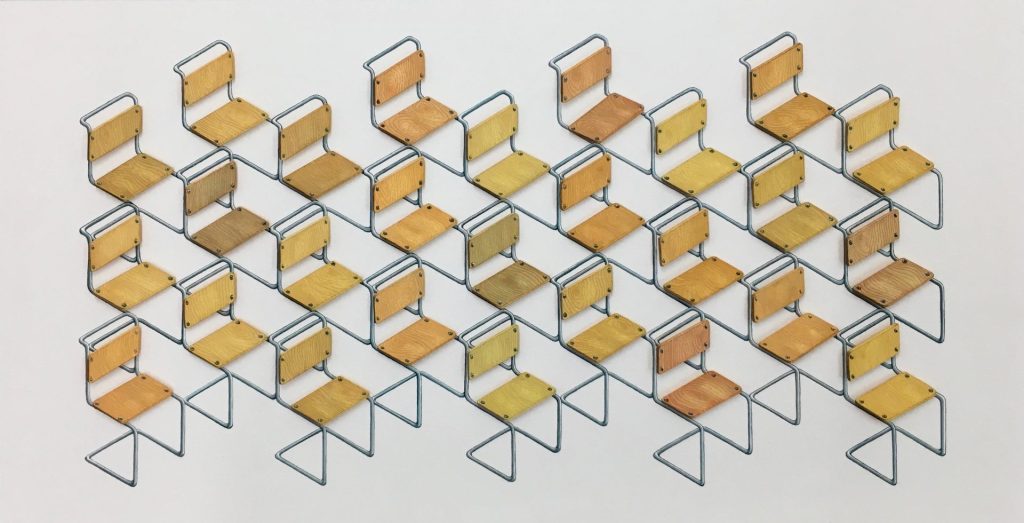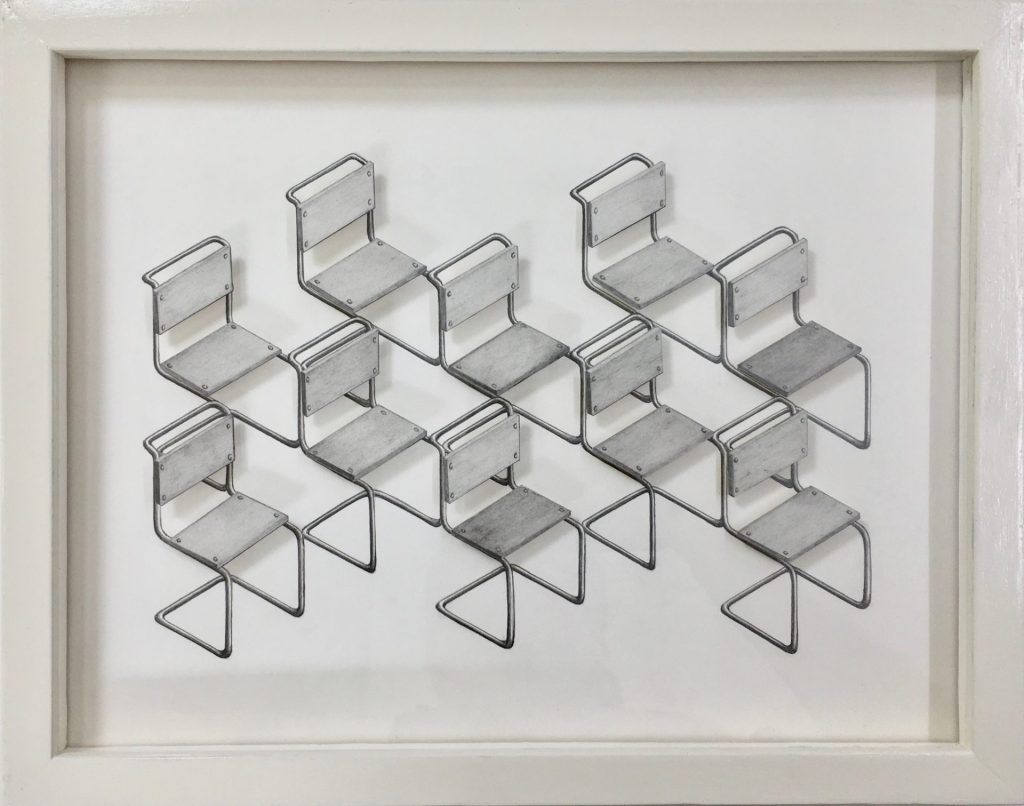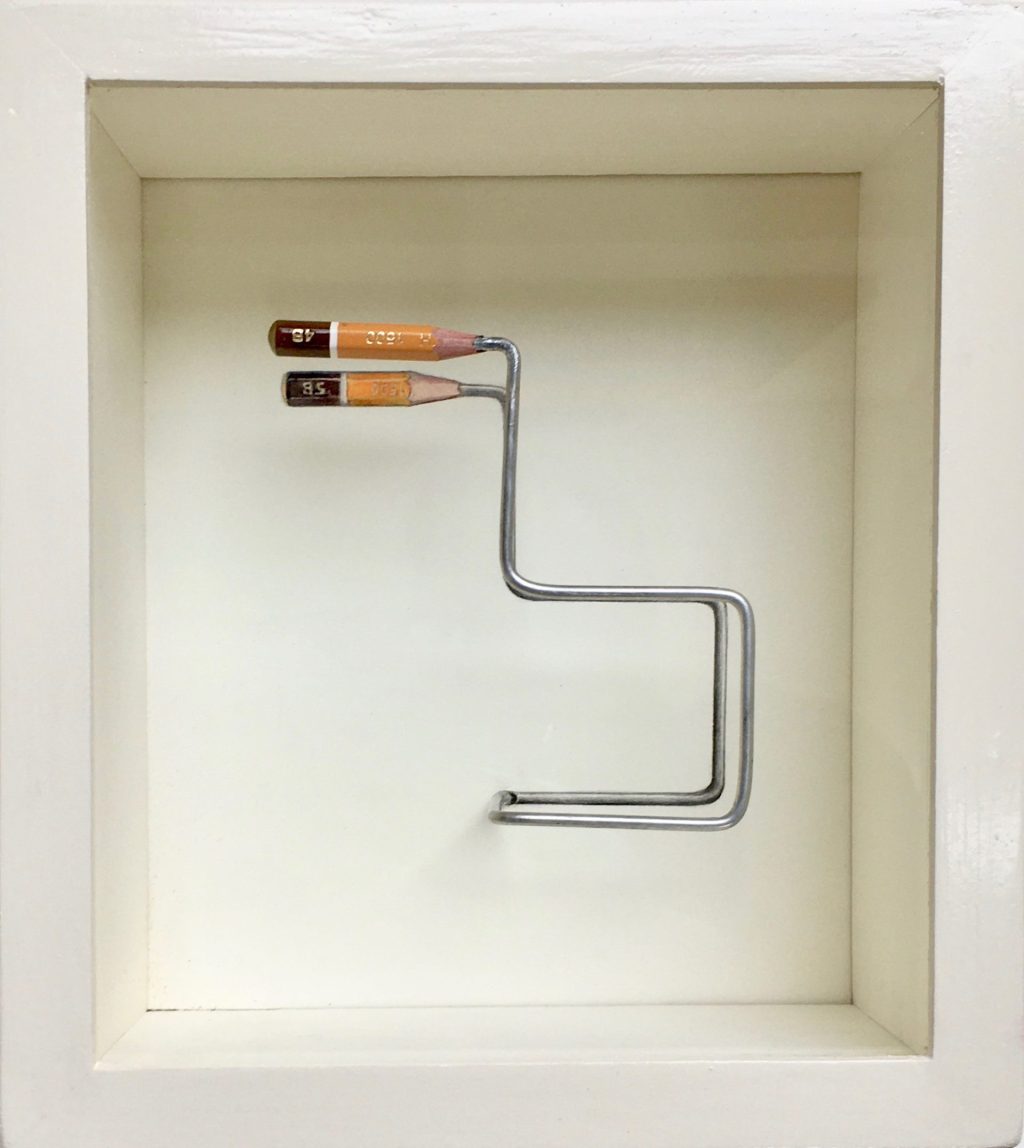2023
Turnover
This drawing was created while freewheeling in my sketchbook. Too stimulating to pass up, so I worked on it straight away. Isometry and the ‘Freischwinger‘ are a good combination.
Stop framing us
For an artist who makes his own frames and who likes to juggle with language, the English word ‘to frame’ is a godsend. See my series Framing Rietveld or more recently Framed II and Framed IV and Unframe. In recent years, despite my best intentions, my drawings have sometimes tended to squeak, crawl, or more brutally stick out of the frame. That idiosyncrasy manifests itself very emphatically in this work where the depicted chairs take a stand against me. I don’t know if I’m going to give them their way.
Lean on me
We sit too much, you hear more and more. But with increasing knowledge of ergonomics, chairs are also becoming more suitable, so that the urge to leave the sitting position is completely vanishing. What incentive can we use to turn this tide? Barbed wire!
A failed attack
Of course this follows on from my earlier drawing The Attack. But why saw four legs at the same time? Anyone who has delved a little deeper into my work knows my love for cartoons. This is clearly evident in Strip, for example. Those four synchronized sawyers are of course the Daltons and not so much the real ones from the Wild West but those of cartoonist Morris, the inventor of Lucky Luke. Four legs, four crooks, with that I started and while searching for an appropriate chair I got stuck again at Gerrit Rietveld’s Military Chair. So far so good, but when I literally finished the drawing it occurred to me that I had overlooked a ‘detail’. The real Daltons date from the second part of the 19th century and this chair by Rietveld is from 1923, which is roughly half a century apart. Truly a failed attack.
The Assault
A chair leg is suddenly sawn here from a completely unexpected angle. And that on a chair by the renowned dutch architect and designer Gerrit Rietveld! In this case even his military chair. Would that mean anything?
Uitbraak II
When there are conflicting interests involved, moving along can sometimes be a solution. Who makes the move is point two. In this case it is the frame so it seems.
Levelen IV
In the series of ‘levelen’ this is also literally the next level because this time it consists of three layers. Once again indebted to the unsurpassed tubular frame chair, and more specifically the one made from one tube. Ode again to Mart Stam as far as I’m concerned. This chair lends itself particularly well in an isometric grid, see previous works such as Descendants and Descendants II. The isometric system, also known as ‘Japanese perspective’, is particularly known by MC Escher, who based many of his works on it.
Levelen III
While making Levels, this possibility popped up in my head while drawing. It required some headaches, how exactly, but yes, then it is best to just start. No sooner said than done and see the result here. Credits again to Mart Stam, what a wonderful invention that ‘one-tube frame chair‘! (This last link is in Dutch, maybe google-translate can help?)
Levelen II
The single-tube frame chair lends itself perfectly to this kind of rhythmic compositions with which I can combine my interest in patterns very well.
Depicted so flat via a photo, and now on a screen, you miss the subtle layering that is in the work. Commit yourself by looking at the work from different angles and the image seems to move. Grab the next opportunity to come and see it in real time.
Levelen
Unframe a drawing I had just finished asked for this sequel. At a certain distance it looks like a pattern of 10 tubular frame chairs. But is that true? Two patterns that interfere and, depending on the position you take as a viewer, produce an ever subtly changing image. A kind of kinetic art where the energy has to come from you as a viewer.
I also made this as a preliminary study for a larger work in color on watercolor cardboard. This one will follow next summer.
Unframe
Already two years ago I made Levitation and this is a direct successor of course, which does not mean that I was aware of that when I made this one. This way you see that you can end up in a place where you once were via yet another way. I especially like this spatial game because you can actually only play it ‘live’. Play along!
Elevate
When is a drawing still a drawing? I usually draw in pencil. Look at my ‘drawing’ The making of.. and there I draw with iron wire. I continue that line in this work. The seat and back are made with the paper, simili japon, which I always draw on. Do I sign it now?
Twee rolstoelen
The first impression, looking at all the other chairs I’ve drawn over the years, is undoubtedly “Why a wheelchair?”. And indeed the more there is added on a chair, no matter how functional, the less my interest in it. At the same time, I come across one quite often, so somewhere such a chair is always latently present. Semantically, you can philosophize about when a wheelchair is a wheelchair? I did that with this as a result. Incidentally, I expect that this (left) wheelchair will remain an exception. (In dutch a ‘rol’ is also a cylinder/role what makes it difficult to translate it in English)
The making of
When drawing the line comes from the pencil and in line with that thought I started making this work. I must add that the idea has been boosted by the fact that it often happens that the core of the pencil, the graphite rod, is significantly shorter than the Koh-I-Noor pencil is long. Then you look into a small black hole where a piece of iron wire fits exactly….




